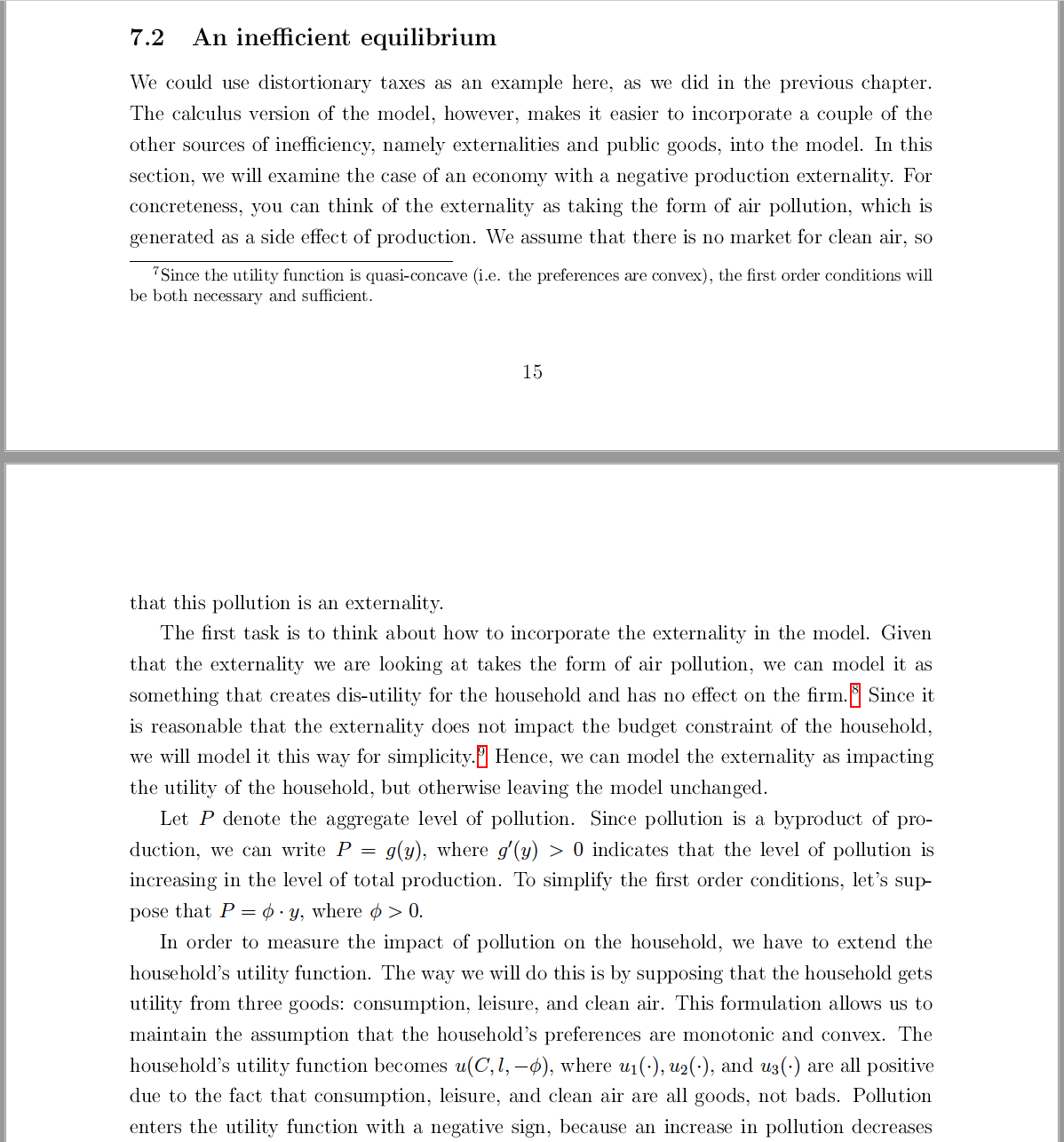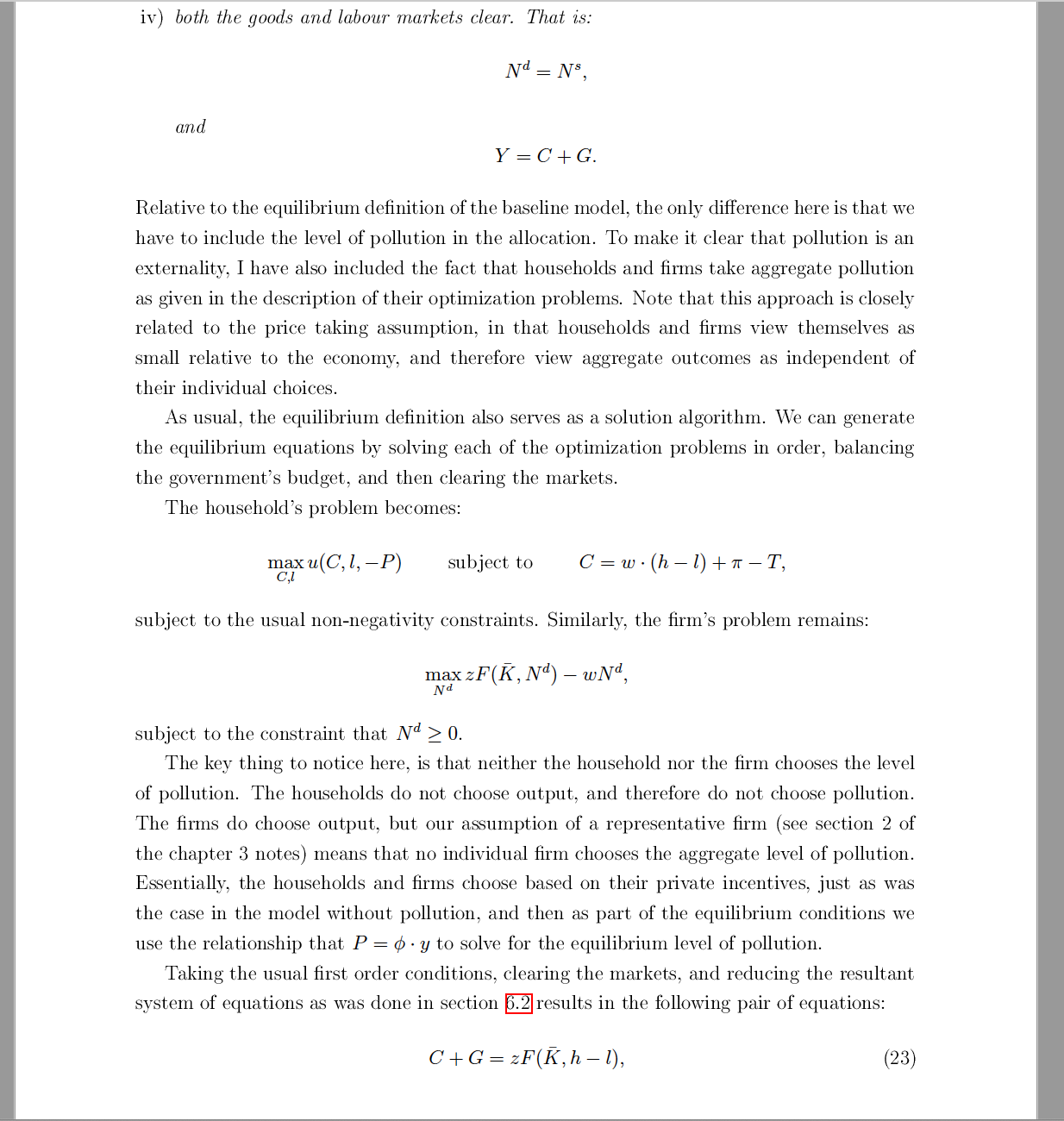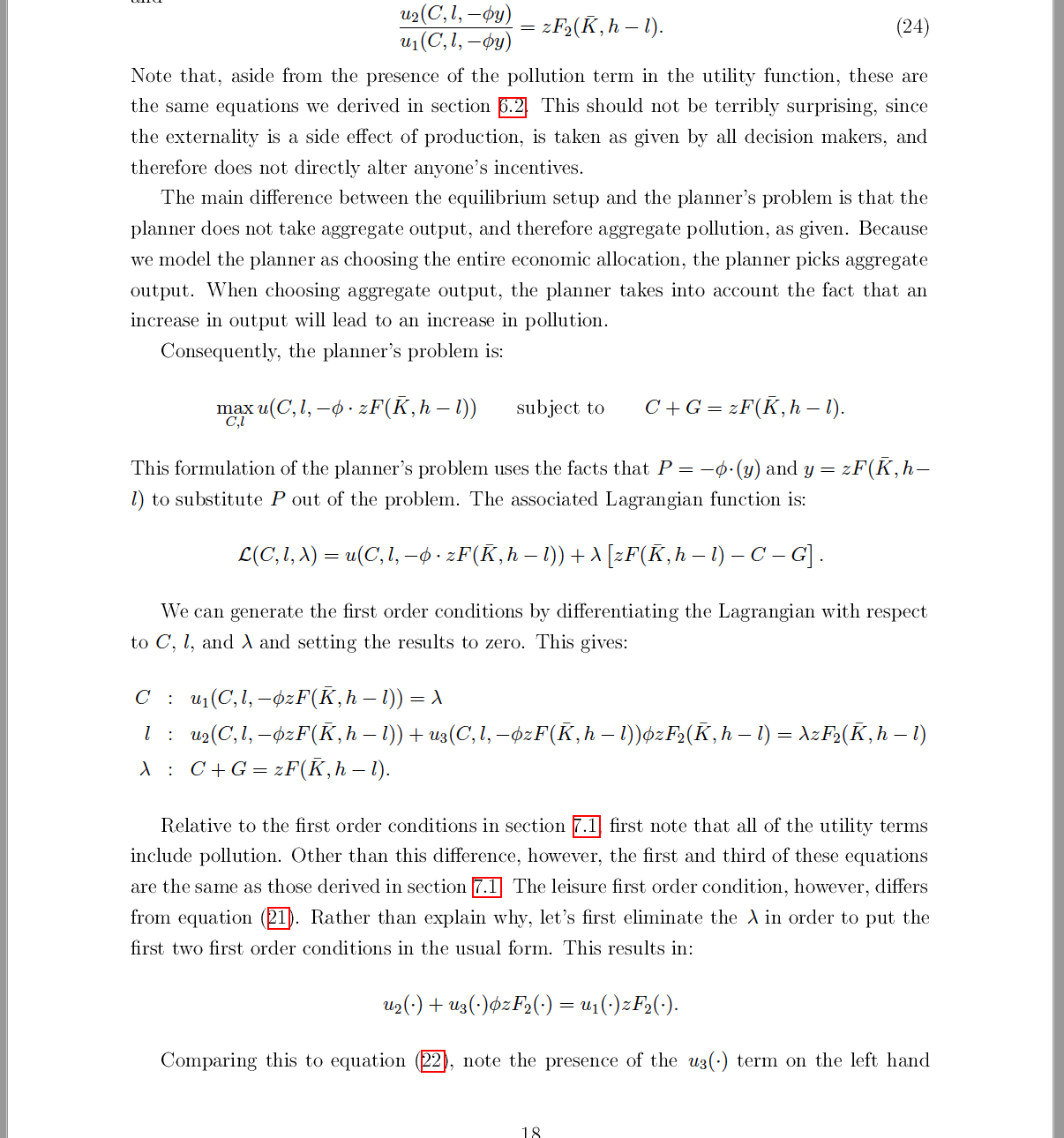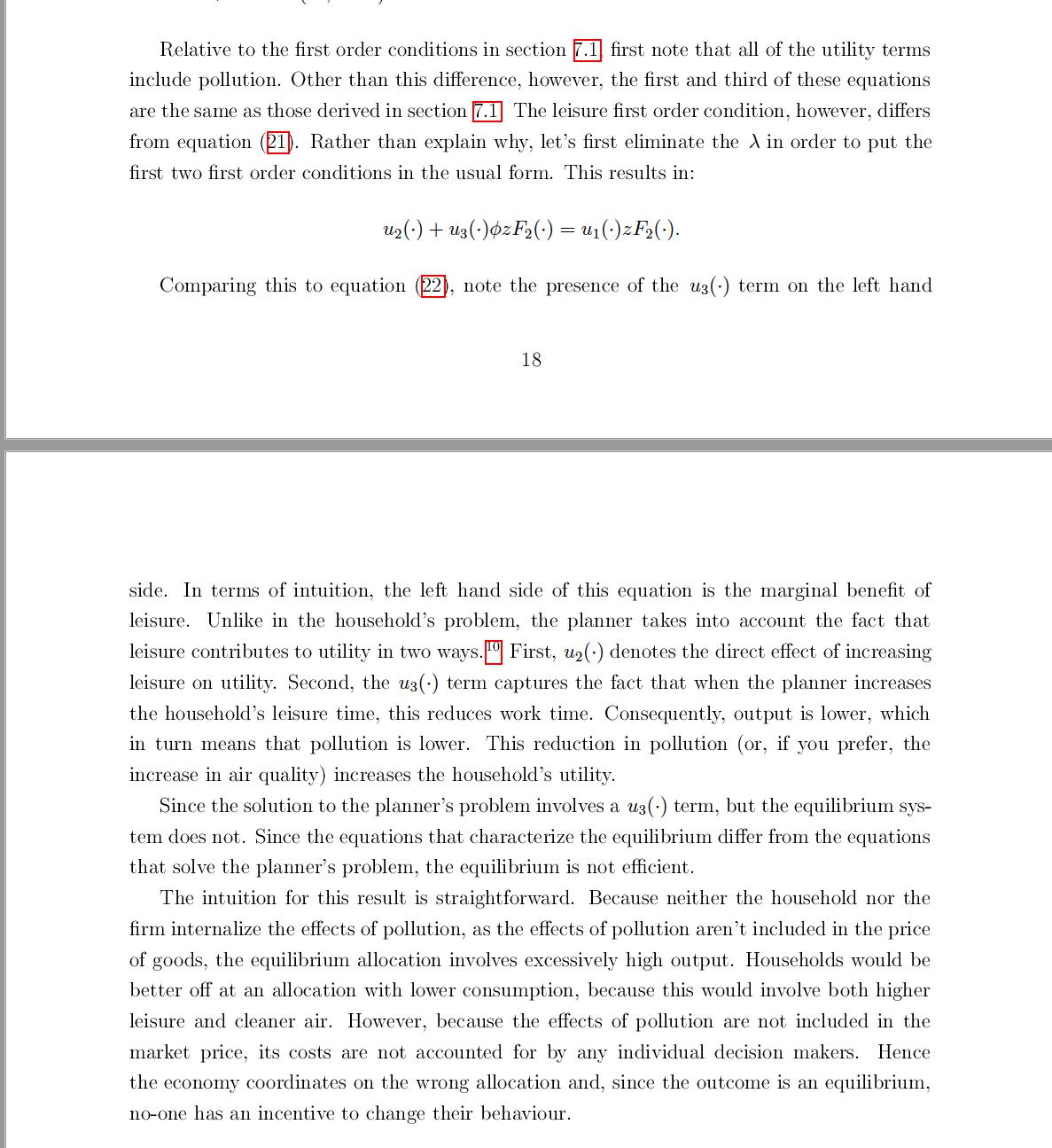





I will post the question and the note section related to the question.
3. Consider the inefficient equilibrium from section 7.2 of the notes, but let G =T =0. Starting from there, outline a government tax or subsidy program that would be able to implement the efficient outcome. Be careful to make sure that your government program, results balances its budget. Explain why your proposed policy will solve the problem in the context of the static general equilibrium model with production (i.e. you should explicitly refer to equilibrium outcomes, not just the incentives of one of the decision makers). [3 points]7.2 An ine'icient equilibrium We could use distortionary taxes as an example here, as we did in the previous chapter. The calculus version of the model, however, makes it easier to incorporate a couple of the other sources of inefficiency, namely externalities and public goods, into the model. In this section, we will examine the case of an economy with a negative production externality. For concreteness, you can think of the externality as taking the form of air pollution, which is generated as a side effect of production. We assume that there is no market for clean air, so TSince the utility function is quasi-concave (i.e. the preferences are convex), the rst order conditions will be both necessary and sufficient. 15 that this pollution is an externality. The rst task is to think about how to incorporate the externality in the model. Given that the externality we are looking at takes the form of air pollution, we can model it as something that creates dis-utility for the household and has no effect on the firm Since it is reasonable that the externality does not impact the budget constraint of the household, we will model it this way for simplicity Hence, we can model the externality as impacting the utility of the household, but otherwise leaving the model unchanged. Let P denote the aggregate level of pollution. Since pollution is a byproduct of pro- duction, we can write P = g(y), where g'(y) > 0 indicates that the level of pollution is increasing in the level of total production. To simplify the rst order conditions, let's sup- pose that P = g6 - y, where (,6 > 0. In order to measure the impact of pollution on the household, we have to extend the household's utility function. The way we will do this is by supposing that the household gets utility from three goods: consumption, leisure, and clean air. This formulation allows us to maintain the assumption that the household's preferences are monotonic and convex. The household's utility function becomes u(C,l, *d'): where u1(-),u2(-), and a3(-) are all positive due to the fact that consumption, leisure, and clean air are all goods, not bads. Pollution enters the utility function with a negative sign, because an increase in pollution decreases household's utility function. The way we will do this is by supposing that the household gets utility from three goods: consumption, leisure, and clean air. This formulation allows us to maintain the assumption that the household's preferences are monotonic and convex. The household's utility function becomes v.(C,l, ), where u1(-),u2(-), and u3(-) are all positive due to the fact that consumption, leisure, and clean air are all goods, not bads. Pollution enters the utility function with a negative sign, because an increase in pollution decreases the cleanliness of the air that the household breathes. A competitive equilibrium of this version of the model is: An Allocation: {0, Nat Y, Nd, 71', T, P}, and Prices: {w} such that: i) the household chooses 0, N3, andl to maximize its utility given its budget constraint, urhile taking prices, aggregate pollution, and tastes as given, ii) the rm chooses Y and Nd to maximize prots given its production technology, urhile taking prices and aggregate pollution as given, iii) the government chooses T to balance its budget given G, and 3we could model the externality as a'ecting the rm too. This would be the case, for example, if pollution reduced the health of workers, and therefore their productivity. For simplicity, however, we will suppose that this doesn't happen. 9You could argue that pollution might have a health impact that would cost the household money, say in medical expenses or in purchases of protective equipment. Given the abstract nature of our model, it's not clear that including these costs would generate any additional insight, so we will ignore them. 16 iv) both the goods and labour markets clear. That is: N = N3, and iv) both the goods and labour markets clear. That is: Nd : N\Mun.\" 11.2(0, l, e5y) u] (C, l, y) Note that, aside from the presence of the pollution term in the utility function, these are = zF2(K, h a). (24) the same equations we derived in section @ This should not be terribly surprising, since the externality is a side effect of production, is taken as given by all decision makers, and therefore does not directly alter anyone's incentives. The main difference between the equilibrium setup and the planner's problem is that the planner does not take aggregate output, and therefore aggregate pollution, as given. Because we model the planner as choosing the entire economic allocation, the planner picks aggregate output. When choosing aggregate output, the planner takes into account the fact that an increase in output will lead to an increase in pollution. Consequently, the planner's problem is: r%a?(u(C,I,-ZF(I_{,hi)) subject to 0+0: zF(K,h I). This formulation of the planner 's problem uses the facts that P = c25-(y) and y = zF(I_(, h i) to substitute P out of the problem. The associated Lagrangian function is: 5(0, 2, A) 2 m0, ;, . zF(K, h 0) + A [2F(K, h z) C G]. We can generate the rst order conditions by differentiating the Lagrangian with respect to C, l, and A and setting the results to zero. This gives: 0 : u1(C,l, 2F(f(,h 3)) = A s : mm, s, zF(f(, h 3)) + \"3(0, ;, zF(f(, h l))zF2(f(, h 1) = AzF2(f{, h a) A : C+G=zF(K,hi). Relative to the rst order conditions in section rst note that all of the utility terms include pollution. Other than this difference, however, the rst and third of these equations are the same as those derived in section The leisure rst order condition, however, differs from equation (I. Rather than explain why, let's rst eliminate the A in order to put the rst two rst order conditions in the usual form. This results in: \"20) + U3(')ZF2(') : \"1(')ZF2(')- Comparing this to equation ., note the presence of the U3(') term on the left hand 19 Relative to the first order conditions in section /.1 first note that all of the utility terms include pollution. Other than this difference, however, the first and third of these equations are the same as those derived in section 7.1 The leisure first order condition, however, differs from equation (21). Rather than explain why, let's first eliminate the A in order to put the first two first order conditions in the usual form. This results in: 2 2 ( . ) + 23 ( . ) 0 z F 2 ( . ) = 21 (. ) = F2(.). Comparing this to equation (22), note the presence of the us(.) term on the left hand 18 side. In terms of intuition, the left hand side of this equation is the marginal benefit of leisure. Unlike in the household's problem, the planner takes into account the fact that leisure contributes to utility in two ways. First, u2(.) denotes the direct effect of increasing leisure on utility. Second, the us( ) term captures the fact that when the planner increases the household's leisure time, this reduces work time. Consequently, output is lower, which in turn means that pollution is lower. This reduction in pollution (or, if you prefer, the increase in air quality) increases the household's utility. Since the solution to the planner's problem involves a us() term, but the equilibrium sys- tem does not. Since the equations that characterize the equilibrium differ from the equations that solve the planner's problem, the equilibrium is not efficient. The intuition for this result is straightforward. Because neither the household nor the firm internalize the effects of pollution, as the effects of pollution aren't included in the price of goods, the equilibrium allocation involves excessively high output. Households would be better off at an allocation with lower consumption, because this would involve both higher leisure and cleaner air. However, because the effects of pollution are not included in the market price, its costs are not accounted for by any individual decision makers. Hence the economy coordinates on the wrong allocation and, since the outcome is an equilibrium, no-one has an incentive to change their behaviour


















